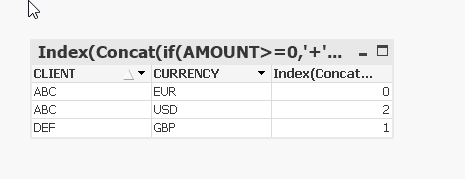Unlock a world of possibilities! Login now and discover the exclusive benefits awaiting you.
- Qlik Community
- :
- All Forums
- :
- QlikView App Dev
- :
- Need help with FirstSortedValue - Negative count u...
- Subscribe to RSS Feed
- Mark Topic as New
- Mark Topic as Read
- Float this Topic for Current User
- Bookmark
- Subscribe
- Mute
- Printer Friendly Page
- Mark as New
- Bookmark
- Subscribe
- Mute
- Subscribe to RSS Feed
- Permalink
- Report Inappropriate Content
Need help with FirstSortedValue - Negative count upto latest positive value
Hi,
I know this should be easy but I've spent hours and just not getting anywhere.
I have a table looks like this:
| DATE | CLIENT | CURRENCY | AMOUNT |
|---|---|---|---|
| 01/01/2016 | ABC | USD | -250 |
| 10/01/2016 | ABC | USD | -151 |
| 14/01/2016 | ABC | USD | 190 |
| 01/01/2016 | ABC | EUR | 185 |
| 27/01/2016 | ABC | EUR | -25 |
| 10/01/2016 | DEF | GBP | -100 |
| 30/01/2016 | DEF | GBP | 0 |
I need an expression to count the number of negative amounts from the starting date up to the date with the latest positive amount. So the result should look like:
ABC USD 2
ABC EUR 0
DEF GBP 1
I'm trying to use FirstSortedValue(DATE,if(AMOUNT>=0,AMOUNT)) but it isn't working.
Any help will be appreciated. sample qvw is attached.
Thanks!
Accepted Solutions
- Mark as New
- Bookmark
- Subscribe
- Mute
- Subscribe to RSS Feed
- Permalink
- Report Inappropriate Content
Will still have to see how it goes with the actual data, but one modification i would propose is to sort the data in a resident load before using Peek/Previous. The reason I say this is because the sample provided here might be sorted in a desired format, whereas original data may differ from this which will end up giving incorrect output.
SET DateFormat='DD/MM/YYYY';
Data:
LOAD * INLINE [
DATE, CLIENT, CURRENCY, AMOUNT
01/01/2016, ABC, USD, -250
10/01/2016, ABC, USD, -151
14/01/2016, ABC, USD, 190
01/01/2016, ABC, EUR, 185
27/01/2016, ABC, EUR, -25
10/01/2016, DEF, GBP, -100
30/01/2016, DEF, GBP, 0
];
FinalData:
LOAD *,
If(Previous(CLIENT) = CLIENT and CURRENCY = Previous(CURRENCY),
If(Previous(AMOUNT)<0,AMOUNT<0, 0), AMOUNT<0) as Flag
Resident Data
Order By CLIENT, CURRENCY, DATE;
DROP Table Data;
- Mark as New
- Bookmark
- Subscribe
- Mute
- Subscribe to RSS Feed
- Permalink
- Report Inappropriate Content
On a given date, you have multiple records per Client and Currency, some negative and some positive. How do you determine which record comes first?
Also, do you need the solution in the frontend or can it be solved in the script?
If latter, please provide a sample input file (potentially with added time stamps).
- Mark as New
- Bookmark
- Subscribe
- Mute
- Subscribe to RSS Feed
- Permalink
- Report Inappropriate Content
Hi,
That's the way the source file is. the objective is to obtain the first positive amount starting with the max date in descending order And then counting the negative amounts for a client currency grouping up to the date obtained earlier. I need this in the front end so that user can select date.
Appreciate your help on this!
- Mark as New
- Bookmark
- Subscribe
- Mute
- Subscribe to RSS Feed
- Permalink
- Report Inappropriate Content
SET DateFormat='D/M/YYYY';
Data:
Load *, If(Previous(CLIENT)=CLIENT And CURRENCY=Previous(CURRENCY),
if(Previous(AMOUNT)<0,AMOUNT<0,
0)
,AMOUNT<0) As Flag;
LOAD * INLINE [
DATE, CLIENT, CURRENCY, AMOUNT
01/01/2016, ABC, USD, -250
10/01/2016, ABC, USD, -151
14/01/2016, ABC, USD, 190
01/01/2016, ABC, EUR, 185
27/01/2016, ABC, EUR, -25
10/01/2016, DEF, GBP, -100
30/01/2016, DEF, GBP, 0
];
PFA..
- Mark as New
- Bookmark
- Subscribe
- Mute
- Subscribe to RSS Feed
- Permalink
- Report Inappropriate Content
Will still have to see how it goes with the actual data, but one modification i would propose is to sort the data in a resident load before using Peek/Previous. The reason I say this is because the sample provided here might be sorted in a desired format, whereas original data may differ from this which will end up giving incorrect output.
SET DateFormat='DD/MM/YYYY';
Data:
LOAD * INLINE [
DATE, CLIENT, CURRENCY, AMOUNT
01/01/2016, ABC, USD, -250
10/01/2016, ABC, USD, -151
14/01/2016, ABC, USD, 190
01/01/2016, ABC, EUR, 185
27/01/2016, ABC, EUR, -25
10/01/2016, DEF, GBP, -100
30/01/2016, DEF, GBP, 0
];
FinalData:
LOAD *,
If(Previous(CLIENT) = CLIENT and CURRENCY = Previous(CURRENCY),
If(Previous(AMOUNT)<0,AMOUNT<0, 0), AMOUNT<0) as Flag
Resident Data
Order By CLIENT, CURRENCY, DATE;
DROP Table Data;
- Mark as New
- Bookmark
- Subscribe
- Mute
- Subscribe to RSS Feed
- Permalink
- Report Inappropriate Content
Agreed, Sunny
- Mark as New
- Bookmark
- Subscribe
- Mute
- Subscribe to RSS Feed
- Permalink
- Report Inappropriate Content
Maybe this espression in a 2 dims chart
Index(Concat(if(AMOUNT>=0,'+','-'), '', DATE), '+')-1

- Mark as New
- Bookmark
- Subscribe
- Mute
- Subscribe to RSS Feed
- Permalink
- Report Inappropriate Content
Perfect. Thanks!
- Mark as New
- Bookmark
- Subscribe
- Mute
- Subscribe to RSS Feed
- Permalink
- Report Inappropriate Content
Thanks, Sunny. Same answer, works great!